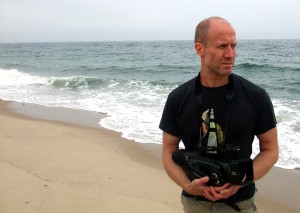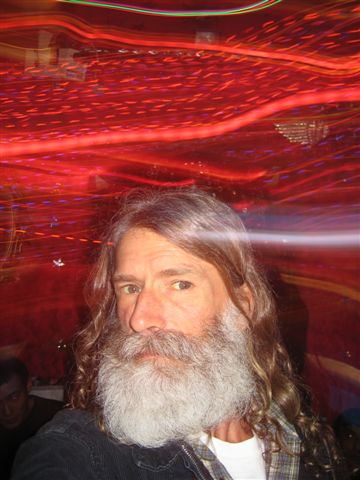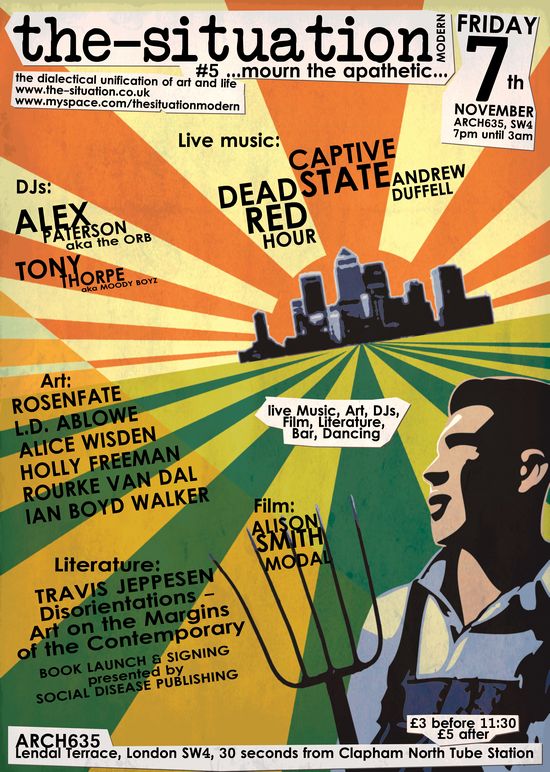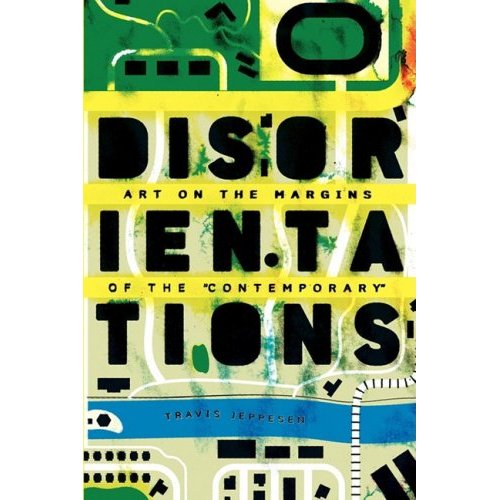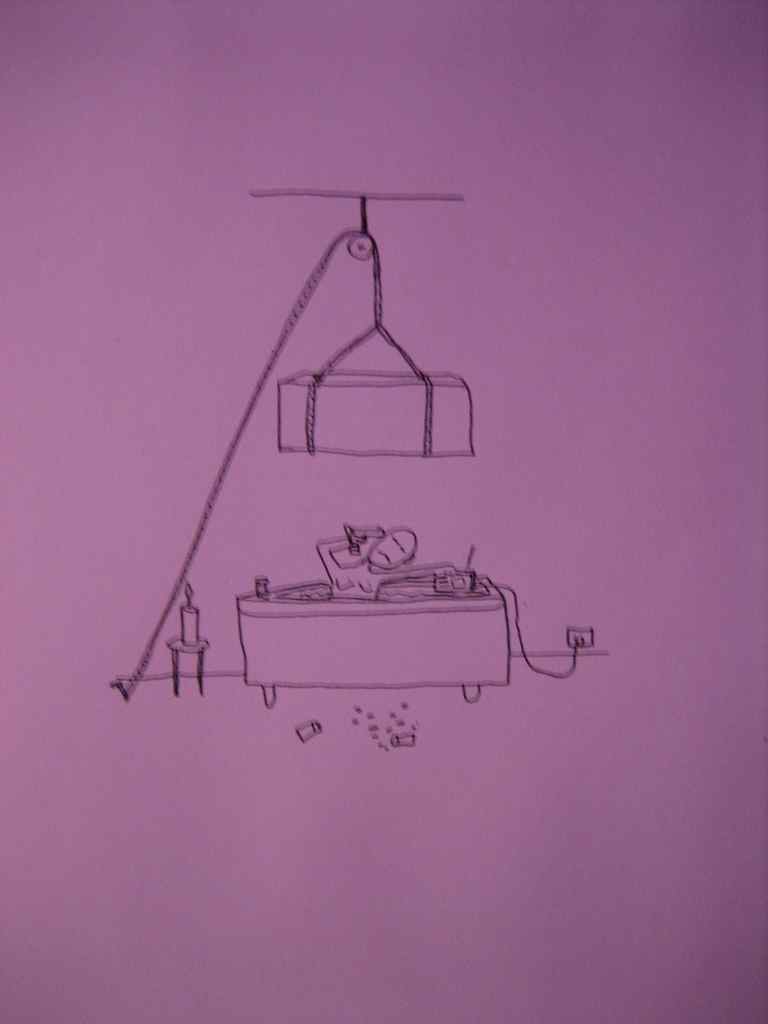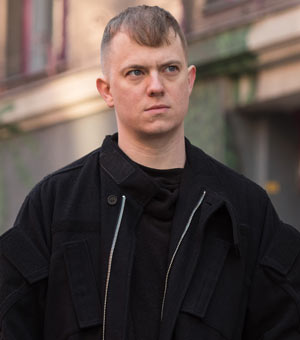Todd Verow at 3. Porn Film Festival Berlin
by Travis Jeppesen on October 26, 2008
I have to admit that I haven’t seen any of Todd Verow’s previous films, but I admire the abrasive, fuck-you aesthetic you find in his latest, Where Your Heart Should Be, which received its world premiere last night at the Porn Film Festival Berlin (the film also screens tonight at 22:15 at Kino Eiszeit for any Berlin readers out there.) While I can’t say that the film is easy to watch, Verow obviously knows this and wouldn’t have it any other way. He wants the experience of watching the film to be as painful for the audience as it was for the filmmaker in making it.
Impossible to summarize, the film works as a sort of visual diary recording its author’s de-infatuation with love and sex. As Verow states early on in the film [paraphrase alert!], “You want a tagline? I’ll give you a tagline: Film is dead, porn is dead, love is dead, sex is dead.”
The texts employed throughout the film are as brutal and confrontational as the author’s own words, but most of them do not originate from him. Rather, they are taken from letters and e-mails sent by disenchanted ex-lovers. The film is spliced with lots of footage of Verow and his current partner fucking; otherwise, in interview/monologue segments, Verow hires various actors to play him, recounting painful memories of a pre-adolescent gang rape in graphic detail.
Where Your Heart Should Be had a noticeably divisive effect on its audience. There were quite a few walk-outs – always a sign that the filmmaker has done something right. For the fact is that most people are sadly average and don’t want to be confronted with words and images of ugliness and brutality. Those who test themselves by facing it head-on, however, often discover that there is also a lot of beauty embedded within those images. This is odd, because disenchantment isn’t supposed to be pretty. And the ambiguous barrage of emotions provoked by Where Your Heart Should Be tends to have a choking effect. Taken as a whole, though, I think Where Your Heart Should Be is a beautiful film – and the beauty lies in its very abrasiveness. The mere fact of its unclassifiability signifies a unique rogue presence in the world of independent filmmaking. I’m looking forward to tracking down more of Verow’s films.
Katharina Klewinghaus at 3. Porn Film Festival Berlin
by Travis Jeppesen on October 26, 2008
As someone who was addicted to slasher films as a child in the 1980s, and who went on to read a ton of feminist and queer theory at university in the 1990s, I’ve long been fascinated with the contradictory ways that women and sex are portrayed in the horror genre. It is a subject that has fascinated academics throughout the last decade, as well, and one that’s been in dire need of a documentary treatment for some time. Now, thanks to Katharina Klewinghaus, star of Bruce LaBruce’s new film Otto; or, Up with Dead People!, that documentary has arrived: Science of Horror, which was screened this weekend at the Porn Film Festival.
Klewinghaus had the savvy to bring together some of the more well known directors of the horror genre, as well as a range of writers and academics who have illuminated the subject through their work. While you might not agree with all of the arguments being put forth, Klewinghaus never appears to take sides and none of the points ever seem belabored – a sign of great filmmaking. Considering that this is Klewinghaus’s first feature, this is quite an impressive feat.
Women were largely relegated to one of two roles in the strictly codified proceedings of the horror film – the studious virgin/hero or the party-harty whore/victim. If I have one minor criticism of the film, it is that the (largely male) filmmakers interviewed failed to address the topic of gender. While they were eager to speak about the function of sex in the films – drawing comparisons to the language of pornography – it would have been interesting to hear their thoughts on the function of gender. Were they conscious of what they were doing in relegating the role of women in their filmic universes, or were their values so engrained in the cultural climate of America in the 1980s, wherein the moral majority was forcing its “family values” propaganda on the population, that they felt it necessary to reinforce these values through their art?
That aside, Science of Horror is one of the most intriguing documentaries I’ve seen this year.
Charles Lum at the 3. Porn Film Festival Berlin
by Travis Jeppesen on October 25, 2008
One of the highlights of this year’s Porn Film Festival was last night’s screening of a suite of short films by Charles Lum, The HIV Collection. Taken together, the films form a fractured feature of sorts that sustains itself thematically through a deployment of repetition that borders on confrontation, yet is never tedious. The films are extremely personal, and address various facets of the artist’s life as an HIV-positive gay man – particularly his pained ambivalence surrounding issues of sex and discretion.
Morning, Noon & Night serves as a sort of “day in the life” of Lum. Park, at only seven minutes, is one of the best (and funniest) films about cruising I’ve yet seen. The longest film, facts. SUCK, is as blunt as its title, portraying Lum’s conversations with his own doctors, shrinks, nurses, and pharmacists, then juxtaposing these interactions with footage of himself speaking directly to the camera on issues of desire and self-image. In Indelible, we are bombarded with a manic collage of the famous “pig guts” scene from the movie Carrie and footage of cumshots in bareback gay porn; the film is as disturbing as it is funny. Overdue Conversation is a split-screen conversation with one of his close friends, wherein each films the other, about whether it is necessary to disclose your HIV status before having sex with someone. Finally, “black” is another recorded conversation that takes place backstage at the Black Party in New York, wherein Lum interviews another friend about an unsafe sexual encounter he engaged in only moments before.
What makes these films feel so fresh, I think, is Lum’s near total disregard for cinematic convention. In many ways, his approach reminds me of that of the writer Peter Sotos, for whom the direct and explicit conveyance of information takes precedence over lofty notions of form and aesthetics. Lum brings the camera wherever he wants to go and uses it as a tool for his own ends – not to serve some unified conception of art or even a preconceived final product. At the same time, he is never grasping at straws in these films – the camera and the process of recording become an extension of his own being, and work hand-in-hand with whatever the situation happens to produce. There is nothing contrived here, and so it is never boring to watch – you literally don’t know what’s going to happen from minute to minute. It would be interesting to see if Lum could sustain this momentum over the course of a longer film.
In short, Lum’s willingness to submit to the momentary chaos of the life he lives, and generously presents, makes for fascinating viewing material. Taken together, the films comprising The HIV Collection form a complex self-portrait that lingers in the mind long after you watch it, sparking as it does so many questions: questions that are so important, most of us devote our lives to ignoring, rather than confronting them. It is for this reason I believe The HIV Collection will come to be regarded as a classic.
PORN AGAIN: 3. Porn Film Festival Berlin
by Travis Jeppesen on October 24, 2008
This week I’ll be “reporting” from the third installment of Berlin’s Porn Film Festival. By reporting, I mean that I’ll be catching films here and there, discussing what I’ve seen, exploring general issues that arise in the conflation of art and porn, and delivering final verdicts – not on the Festival itself; I think the mere fact of its existence is a wonderful thing – but on the films I happen to see.
This is my second year attending the Festival. For me, the highlight of last year’s festival was the discovery that, despite the blatancy of its name, the organizers’ interpretation of what constitutes “porn” was actually quite open. That meant getting to see such treats as LLIK YR IDOLS, the recent documentary on the New York No Wave scene of filmmakers, many of whom arguably employed elements of porn in their work; a beautiful documentary exploring the nature of bestiality, the title of which I’ve unfortunately forgotten; the first Israeli gay erotic feature film; plus a whole host of shorts, including Bruce LaBruce’s recent Give Piece of Ass a Chance.
This year’s Festival will include a special focus on Asian porn cinema; directors Charles Lum, Petra Joy, William E. Jones, and Ola Ege; an exploration of the career of porn legend Jack Wrangler; plus the usual program of features, documentaries, shorts, and an ambitious program of lectures, workshops, and nightclub events.
What has impressed me so far about the Festival is its curatorial integrity. The fact that so many filmmakers have refused to allow their films to be screened at the Porn Film Festival because of its name just shows you how stupidly moralistic and righteous our culture remains in the 21st century. Ironically, a lot of films focusing on some aspect of the porn industry – even films including the word “porn” in the title – have refused to show at the Porn Film Festival Berlin. (See this interesting statement from the Festival organizers for more on this.)
While there are films from hardcore porn studios being shown, these films comprise a small segment of the Festival program. What you find when attending the Berlin festival is a rigorous filmic examination of the very notion of pornography – from both contemporary and historical vantage points. It seems to me that the Festival’s primary focus is on constructing a bridge between two superficially separate realms – “art” and “porn” – effectively uniting them. That there is no one correct way to go about doing this is testament to the Festival’s diversity and legitimacy.
Even if the filmmakers who refused to show in the Berlin Porn Film Festival don’t get this, at least the audience does. Judging solely on looks alone, this is no porno convention. You won’t find cliché plastic blonde vixens, shaky old men in raincoats, or overweight pony-tailed sleaze merchants haunting the halls of the Porn Film Festival venues. Instead, artists, intellectuals, and bohemians of all ages and sexual orientations are filling the halls and auditoriums. While it may not draw the largest crowds, the fact that it attracts the elite of the cutting edge endows the Berlin Porn Film Festival with a buzz sadly lacking in more mainstream film festivals.
VILE: A Note on Jeff Koons Versailles
by Travis Jeppesen on October 19, 2008
The mainstream media’s recent attempts at writing off the critics of Jeff Koons’s Versailles exhibition as “conservative” miss a simple point:
Jeff Koons is probably the worst living artist, if not one of the worst artists who ever lived. This is not a political argument, but an aesthetic truth.
In fact, the ponderous garbage that Koons produces sullies the very word art, and you don’t have to be an art critic or an intellectual to figure this out – you just have to have eyes.
Provocation on its own is fine and can even be great. But unless you’re some soft-headed puritan from the Midwest, there is nothing remotely offensive or provocative about Koons’s so-called work in terms of content. Rather it is meant to offend through sheer tackiness. It is no compliment to Koons that his execrable non-efforts are successful in this dubious realm. It is a sign of mass stupidity, blindness, and vulnerability to manufactured reputations that he has become so successful materially.
We must always question the legitimacy of any institution or gallery that, by showing Jeff Koons, attempts to legitimize him as an artist.
3 Reasons Why Art Writing Still Earns a Bad Name
by Travis Jeppesen on October 18, 2008
You can read my short essay on said topic in the latest issue of Dazed & Confused. It’s pretty much a condensation of my thesis in Disorientations: Art on the Margins of the “Contemporary”.
Thiago Rocha Pitta at Andersen’s Contemporary, Berlin
by Travis Jeppesen on October 16, 2008
Notes on an Island Shipwreck is a simple project exploring the polar motifs of land and sea. Thiago Rocha Pitta is restrained in his approach, and the exhibition is well thought-out, though not extraordinary. The centerpiece, Project for a Stormy Weather Painting, is a large piece of canvas upon which water, soil, and pigment have forged the violet gray blackness of a storm at sea. It could also just be a dirty cloth hung in an elegant manner. Behind the piece, on either side two videos play, behind a wall. The first, Heritage, shows a boat with two trees planted in soil sailing across the ocean. The second, Inland Shipwreck, documents the burial of said boat, sans tree, in the earth. In a room upstairs, a single photograph captures a still from the former video; it looks as though trees are growing out of the water. It is somehow the most moving piece in the entire exhibition.
There is more, though. The office contains the boat itself, or a replica thereof, with soil and trees intact.
Then there are three unremarkable watercolor Sketches for sultriness, stills of the Inland Shipwreck, and Fossil Rain, a photo of huge rock formations withered with strange lines, presumably an after-effect of acid rain. All these things feel supplementary, if not excessive, to the work previous mentioned.
Thiago Rocha Pitta is said to have created this work out of homage to Joseph Conrad, the sailor and writer who was in many ways indebted to the Romantic tradition of the 18th and 19th centuries. Perhaps this is why you get such a quaint sensation looking at the artist’s project. With a slight nod to the environmental catastrophe that has reached global proportions, Pitta seems to be concerned with making sense of his subject matter, rather than heralding it. Perhaps the artist has in mind a more poignant idea – that nature has lost all the mysterious, wild attributes of the sublime that the Romanticists once hailed in this age of rigid pragmatism and scientific certainty. Whatever the case may be, you leave the gallery with the rather ambivalent impression that the artist’s engagement with both his materials and subject matter has been desultory at best.
For Jan Jakub Kotik, at 3am
by Travis Jeppesen on October 16, 2008
I do an occasional poetry column with Matthew Wascovich at 3ammagazine.com. In the latest installment, now online, you can read my homage to Jan Jakub Kotik.
Olaf Breuning’s Ultimate Suicide
by Travis Jeppesen on October 7, 2008
PLUS: Read an essay on Olaf Breuning’s Home in Disorientations

